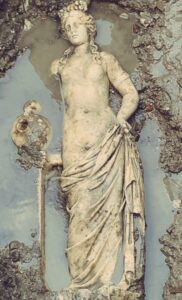 Excavations in the ancient city of Amastris, modern-day Amasra on the Black Sea coast of northern Turkey, have discovered a statue of a water nymph in unusually complete condition. She is missing only the left side of her nose and her right hand. Archaeologists estimate that the statue dates to the 2nd century A.D.
Excavations in the ancient city of Amastris, modern-day Amasra on the Black Sea coast of northern Turkey, have discovered a statue of a water nymph in unusually complete condition. She is missing only the left side of her nose and her right hand. Archaeologists estimate that the statue dates to the 2nd century A.D.
The statue is life-sized at 1.53 meters (five feet) high and depicts a nude female figure resting on an urn perched atop a pilaster. Her right hand clutches the robe draped loosely over her hips. Her hair is tied in a Herakles knot (aka an Aphrodite knot), a hairstyle that originated in Early Classical (5th century B.C.) depictions of Apollo and then became popular in statues of Aphrodite and other deities throughout the Classical, Hellenistic and Roman eras. It looks to me from the picture that there might even be remnants of blue polychrome on the draped robe, although that could just as well be some sort of stain.
 Amastris was an ancient Greek city prominent enough to get a mention in The Iliad. It flourished in trade thanks to its location on the southern Black Sea coast and access to large amounts of boxwood. Part of the Kingdom of Pontus since the mid-3rd century B.C., Amastris was captured by Rome in 70 B.C. and by the time the statue was made, was a prosperous city in the Roman imperial province of Bithynia-Pontus.
Amastris was an ancient Greek city prominent enough to get a mention in The Iliad. It flourished in trade thanks to its location on the southern Black Sea coast and access to large amounts of boxwood. Part of the Kingdom of Pontus since the mid-3rd century B.C., Amastris was captured by Rome in 70 B.C. and by the time the statue was made, was a prosperous city in the Roman imperial province of Bithynia-Pontus.
Pliny the Younger, nephew and heir of the famed author of Natural History who died trying to save his friends from the eruption of Vesuvius in 79 A.D., was appointed imperial governor of Bithynia-Pontus by the Emperor Trajan in 100 A.D. Many of his letters have survived, including his letter to the historian Tacitus describing the eruption that took his uncle’s life, and his correspondence with Trajan. Around 112 A.D., he wrote to Trajan about Amastris in particular.
The elegant and beautiful city of Amastris, Sir, has, among other principal constructions, a very fine street and of considerable length, on one entire side of which runs what is called indeed a river, but in fact is no other than a vile common sewer, extremely offensive to the eye, and at the same time very pestilential on account of its noxious smell. It will be advantageous, therefore, in point of health, as well as decency, to have it covered; which shall be done with your permission: as I will take care, on my part, that money be not wanting for executing so noble and necessary a work.
Trajan’s reply:
It is highly reasonable, my dearest Pliny, if the water which runs through the city of Amastris is prejudicial, while uncovered, to the health of the inhabitants, that it should be covered up. I am well assured you will, with your usual application, take care that the money necessary for this work shall not be wanting.
 The statue is now undergoing cleaning and conservation. It will be placed on display at the Amasra Museum when conservation is complete.
The statue is now undergoing cleaning and conservation. It will be placed on display at the Amasra Museum when conservation is complete.
If not mistaken, this “discovery” took place in 2004?
Remarkable find. The photo appears to show a pipe or tube in the neck of the jug. Could this originally have been part of a public water fountain or a garden feature?